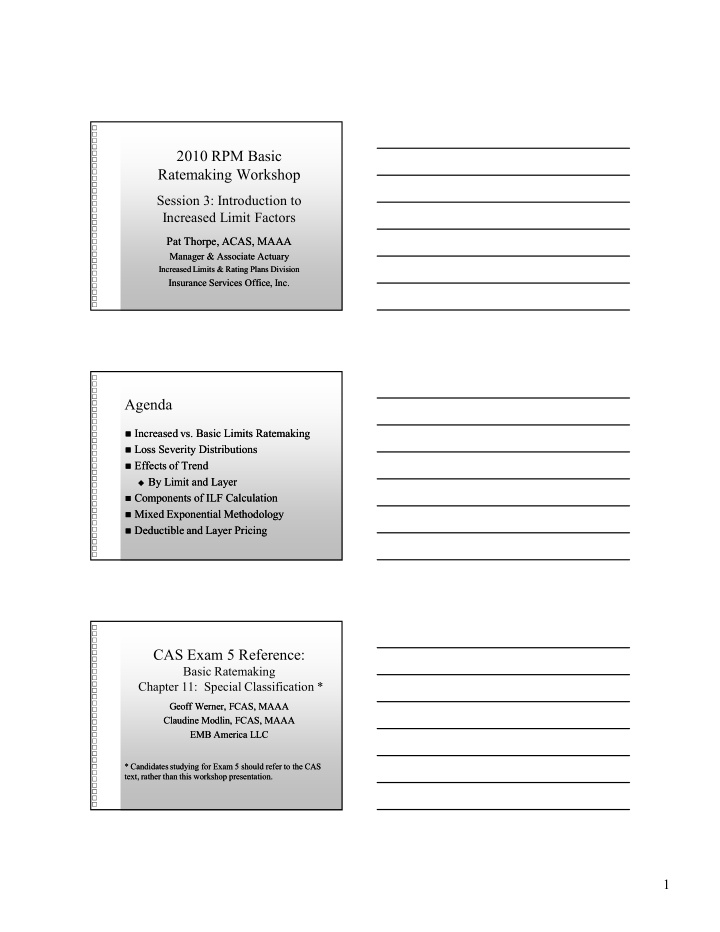



2010�RPM�Basic� Ratemaking�Workshop�� Session�3:�Introduction�to� Increased�Limit�Factors Pat�Thorpe,�ACAS,� Pat�Thorpe,�ACAS,�MAAA MAAA Manager�&�Associate�Actuary Manager�&�Associate�Actuary Increased�Limits�&�Rating�Plans�Division Increased�Limits�&�Rating�Plans�Division Insurance�Services�Office,�Inc.� Insurance�Services�Office,�Inc.� Agenda � Increased�vs.�Basic�Limits�Ratemaking Increased�vs.�Basic�Limits�Ratemaking � � Loss�Severity�Distributions Loss�Severity�Distributions � � Effects�of�Trend� Effects�of�Trend� � � By�Limit�and�Layer By�Limit�and�Layer � � Components�of�ILF�Calculation Components�of�ILF�Calculation � � Mixed�Exponential�Methodology Mixed�Exponential�Methodology � � Deductible�and�Layer�Pricing��� Deductible�and�Layer�Pricing��� � CAS�Exam�5�Reference:� Basic�Ratemaking Chapter�11:��Special�Classification�* Geoff�Werner,�FCAS Geoff�Werner,� FCAS,� ,�MAAA MAAA Claudine� Claudine�Modlin Modlin,� ,�FCAS FCAS,� ,�MAAA MAAA EMB EMB America�LLC� America�LLC� *�Candidates�studying�for�Exam�5�should�refer�to�the�CAS *�Candidates�studying�for�Exam�5�should�refer�to�the� CAS text,�rather�than�this�workshop�presentation. text,�rather�than�this�workshop�presentation. 1
Prior�CAS�Exam�5�Paper:� Increased�Limits�Ratemaking For�Liability�Insurance�* Joseph�M.�Palmer,� Joseph�M.�Palmer,�FCAS FCAS,� ,�MAAA MAAA,� ,�CPCU CPCU Assistant�Vice�President�&�Actuary Assistant�Vice�President�&�Actuary Increased�Limits�&�Rating�Plans�Division Increased�Limits�&�Rating�Plans�Division Insurance�Services�Office,�Inc.� Insurance�Services�Office,�Inc.� *�This�paper�provides�a�description�of�the�Mixed�Exponential� *�This�paper�provides�a�description�of�the�Mixed�Exponential� Methodology�used�by�ISO,�and�is�referenced�in�Chapter�11�of�the�Basic� Methodology�used�by�ISO,�and�is�referenced�in�Chapter�11�of�the�Basic� Ratemaking�text�mentioned�in�the�previous�slide.� Ratemaking�text�mentioned�in�the�previous�slide.� Liability�Lines�of�Business � Premises/Operations� Premises/Operations� � Management� Management� � � and�Products�(GL)� and�Products�(GL)� Protection�(D&O) Protection�(D&O) � Medical�Professional Medical�Professional � E E:Commerce Commerce � � � Commercial�Auto Commercial�Auto � Lawyers�Professional Lawyers�Professional � � � Personal�Auto Personal�Auto � Business�Owners Business�Owners � � � Farm Farm � Employment Employment:Related� Related� � � Practices Practices � Personal�(Individual�or� Personal�(Individual�or� � within�Homeowner� within�Homeowner� � Other�Professional Other�Professional � Policy) Policy) Basic�Limits�Ratemaking� � Use�large�volume�of�losses�capped�at�basic� Use�large�volume�of�losses�capped�at�basic� � limit�for�detailed,�experience limit�for�detailed,�experience:based� based� analysis. analysis. � Able�to�produce�relativities�by Able�to�produce�relativities�by � � Class Class � � Territory Territory � � Tiers Tiers � 2
Increased�Limits�Ratemaking� � Need�broader�experience�base Need�broader�experience�base � � low�claim�volume�at�higher�limits� low�claim�volume�at�higher�limits� � � Group�loss�experience�for�credibility Group�loss�experience�for�credibility � � Class�Groups Class�Groups � � State�Groups State�Groups � � Countrywide Countrywide � Increased�Limit�Factor�Definition Expected�Costs�at�the�desired�policy�limit Expected�Costs�at�the�desired�policy�limit _____________________________________________________________________________________________________________ _____________________________________________________________________________________________________________ Expected�Costs�at�the�Basic�Limit Expected�Costs�at�the�Basic�Limit KEY�ASSUMPTION: KEY�ASSUMPTION: Claim�Frequency�is� Claim�Frequency�is�independent independent of� of� Claim�Severity� Claim�Severity� 3
This�allows�for�ILFs�to�be�developed�by� This�allows�for�ILFs�to�be�developed�by� an�examination�of�the�relative� an�examination�of�the�relative� severities�ONLY severities�ONLY × � ( ��������� ) � ( �������� ) = ��� � � × � ( ��������� ) � ( �������� ) � � ( �������� ) = � � ( �������� ) � Limited�Average�Severity�(LAS) � Defined�as�the�average�size�of�loss,�where� Defined�as�the�average�size�of�loss,�where� � all�losses�are�limited�to�a�particular�value. all�losses�are�limited�to�a�particular�value. � Thus,�the�ILF�can�be�defined�as�the�ratio�of� Thus,�the�ILF�can�be�defined�as�the�ratio�of� � two�limited�average�severities. two�limited�average�severities. � ILF�(k)�=�LAS�(k)� ILF�(k)�=�LAS�(k)�÷ ÷ LAS�(B)�� LAS�(B)�� � Example Losses� Losses� @100,000�Limit @100,000�Limit @1�Mill�Limit @1�Mill�Limit 50,000 50,000 75,000 75,000 150,000 150,000 250,000 250,000 1,250,000 1,250,000 4
Example�(cont’d) Losses� Losses� @100,000�Limit @100,000�Limit @1�Mill�Limit @1�Mill�Limit 50,000 50,000 50,000 50,000 75,000 75,000 75,000 75,000 150,000 150,000 100,000 100,000 250,000 250,000 100,000 100,000 1,250,000 1,250,000 100,000 100,000 ��������� ��������� ������� ������� Example�(cont’d) Losses� Losses� @100,000�Limit @100,000�Limit @1�Mill�Limit @1�Mill�Limit 50,000 50,000 50,000 50,000 50,000 50,000 75,000 75,000 75,000 75,000 75,000 75,000 150,000 150,000 100,000 100,000 150,000 150,000 250,000 250,000 100,000 100,000 250,000 250,000 1,250,000 1,250,000 100,000 100,000 1,000,000 1,000,000 ��������� ��������� ������� ������� ��������� ��������� Example�– Calculation�of�ILF Total�Losses Total�Losses $1,775,000 $1,775,000 Limited�to�$100,000 Limited�to�$100,000 $425,000/5 $425,000/5 (Basic�Limit) (Basic�Limit) =�$85,000 =�$85,000 Limited�to�$1,000,000 Limited�to�$1,000,000 $1,525,000/5 $1,525,000/5 =�$305,000 =�$305,000 Increased�Limits�Factor Increased�Limits�Factor $305,000/85,000 $305,000/85,000 (ILF) (ILF) =�3.588 =�3.588 5
Empirical�Data�: ILFs Lower Lower Upper Upper Losses Losses Occs. Occs. Average Average 1 100,000 100,000 25,000,000 25,000,000 1,000 1,000 25,000 25,000 100,001 100,001 250,000 250,000 75,000,000 75,000,000 500 500 150,000 150,000 250,001 250,001 500,000 500,000 60,000,000 60,000,000 200 200 300,000 300,000 500,001 1�Million 500,001 1�Million 30,000,000 30,000,000 50 50 600,000 600,000 1�Million 1�Million : 15,000,000 15,000,000 10 10 1,500,000 1,500,000 Empirical�Data�: ILFs LAS�@�100,000 LAS�@�100,000 (25,000,000�+�760� (25,000,000�+�760�× × 100,000)� 100,000)�÷ ÷ 1760� 1760� =�57,386 =�57,386 LAS�@�1,000,000 LAS�@�1,000,000 (�190,000,000�+�10� (�190,000,000�+�10�× × 1,000,000�)� 1,000,000�)�÷ ÷ 1760 1760 =�113,636 =�113,636 Empirical�ILF�=��1.98 Empirical�ILF�=��1.98 Insurance�Loss�Distributions � Loss�Severity�Distributions�are�Skewed Loss�Severity�Distributions�are�Skewed � � Many�Small�Losses/Fewer�Larger�Losses����� Many�Small�Losses/Fewer�Larger�Losses����� � � Yet�Larger�Losses,�though�fewer�in�number,� Yet�Larger�Losses,�though�fewer�in�number,� � are�a�significant�amount�of�total�dollars�of� are�a�significant�amount�of�total�dollars�of� loss. loss. 6
Loss�Distribution�: PDF � ( � ) � 0 Loss�Size Claim�Distribution�: CDF � ( � ) 1 Claims � 0 Claims�vs.�Cumulative�Paid�$ $ 1 Liability � 0 � ( � ) Claims $ � 0 Property � 0 7
Recommend
More recommend